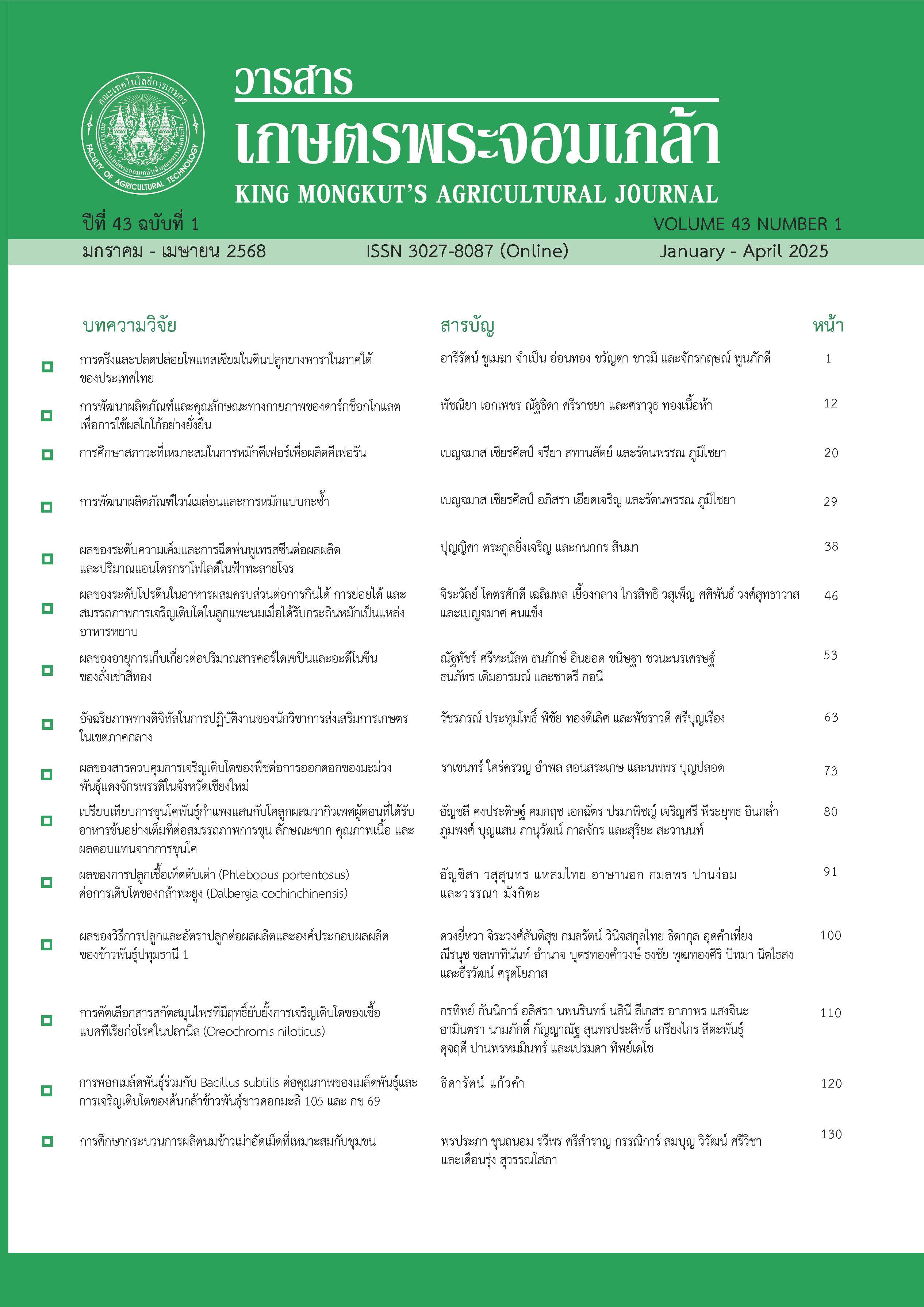Product Development and Physical Characteristics of Dark Chocolate for Sustainable Use of Cocoa Fruit
Main Article Content
Abstract
Cocoa and chocolate are commercial products of great economic importance. Some physical properties of dark chocolate products were studied at three levels of different sugar concentrations: 60%, 80% and 100%. It was found that dark chocolate of 80% sugar concentration had the highest satisfaction at level 8 in terms of flavor, taste and preferences from consumers. Additionally, this formulation exhibited consistent colour properties and an optimal water activity (aw) range for storage stability. Analysis of volatile compounds by Headspace-Solid Phase Microextraction (HS-SPME) Gas Chromatography-Mass Spectrometry (GC-MS) revealed outstanding compounds, which are Butanal, 3-methyl- (C5H10O), Pentanoic acid (C5H10O2), Acetic acid, 2-phenylethyl ester (C10H12O2) and Benzeneethanol (C8H10O), respectively. As for the nutritional information of 80% dark chocolate products, the nutritional values per package unit (30 grams), when consumed in specified amount, are 180 kilocalories of energy, 8 grams of sugar, and 10 grams of fat. These nutritional values amount to 8%, 12% and 15% of the maximum recommendation for daily intakes. These findings suggest that 80% dark chocolate is an optimal choice for consumers seeking reduced sugar intake while maintaining desirable taste characteristics. This research provides valuable insights for the future development of health-oriented chocolate products.
Article Details

This work is licensed under a Creative Commons Attribution-NonCommercial-NoDerivatives 4.0 International License.
King Mongkut's Agricultural Journal
References
Afoakwa, E. O. (2014). Cocoa Production and Processing Technology. CRC Press.
Aidoo, R. P., Afoakwa, E. O., & Dewettinck, K. (2014). Optimization of inulin and polydextrose mixtures as sucrose replacers during sugar-free chocolate manufacture - rheological, microstructure and physical quality characteristics. Journal of Food Engineering, 126(1), 35–42.
Andrae-Nightingale, L. M., Lee, S. Y., & Engseth, N. J. (2009). Texture change in chocolate characterized by instrumental and sensory technique. Journal of Texture Studies, 40(1), 427–444.
Association of Official Agricultural Chemists (1995). Official Methods of Analysis of Association of Official Analytical Chemistry. AOAC.
Belscak-Cvitanovic, A., Komes, D., Dujmovic, M., Karlovic, S., Biskic, M., Brncic, M., & Jezek, D. (2015). Physical, bioactive and sensory quality parameters of reduced sugar chocolates formulated with natural sweeteners as sucrose alternatives. Food Chemistry, 167(1), 61–70.
Broadwin, E. (2018). World Economic Forum. Retrieved from: weforum.org/agenda/2018/01/chocolate-is-on-track-to-go-extinct-in-40-years?fbclid=IwAR2HpRBVPESD0B-DoC9xc1JjPEMG60V25WIoRFI7hqpAfhXPNykw2TvLPIw.
Caporaso, N., Whitworth, M. B., & Fisk, I. D. (2021). Total lipid prediction in single intact cocoa beans by hyperspectral. Food Chemistry, 344(1), 128663.
De Vuyst, L., & Weckx, S. (2016). The cocoa bean fermentation process: from ecosystem analysis to starter culture development. Journal of Applied Microbiology, 121(1), 5-17.
Gibson, M. (2018). Chocolate / Cacao. In Gibson, M. (Ed.), Food Science and the Culinary Arts, pp. 341-351. Academic Press.
Guda, P., Gadhe, S., & Jakkula, S. (2017). Drying of cocoa beans by using different techniques. International Journal of Agriculture Innovations and Research, 5(5), 859-865.
Ilangantileke, S. G., Wahyudi, T., & Gracia Bailon, M. (1991). Assessment methodology to predict quality of cocoa beans for export. Journal of Food Quality, 14(6), 481-496.
Ministry of Commerce. (2018). Growing "Cocoa" makes 80,000 baht per Rai! Office of Agricultural Economics Promote instead of Rubber - Reduces Imports by 50,000 per Year. Retrieved from: www.thansettakij.com/content/356670. (in Thai).
Nazira, S., & Azaz Ahmad Azad, Z. R. (2016). Development of a novel calorie controlled and sugar-free dark chocolate enriched with guar gum. Journal of Food Research and Technology, 4(2), 39-46.
Rakitikun, W., Sirita. J., Yossunthon, P., Changruenngam, T., Nanglae, S. (2022). Analysis of chemical composition to determine the identity of cocoa in Chiang Rai province. Journal of RPRU Science Mathematics and Technology, 1(1), 20-34. (in Thai).
Ramsey, D. (2016). Chocolate. Penguin Random House.
Scott, M. (2016). Climate & Chocolate. Retrieved from: https://www.climate.gov/news-features/climate-and/climate-chocolate.
Singleton, V. L., & Rossi, J. A. (1965). Colorimetry of total phenolics with phosphomolybdic-phosphotungstic acid reagents. American Journal of Enology and Viticulture, 16(3), 144-158.
Srisattabut P. (2018). A study of the amount of fresh butter and the amount of dried longan affecting the acceptance of the sensory quality of longan chocolate products. Journal of Vocational Institute of Agriculture, 2(2), 48-55. (in Thai).
Wansiri, S. (1989). Cocoa Plantation. Thanakaset Press. (in Thai).


